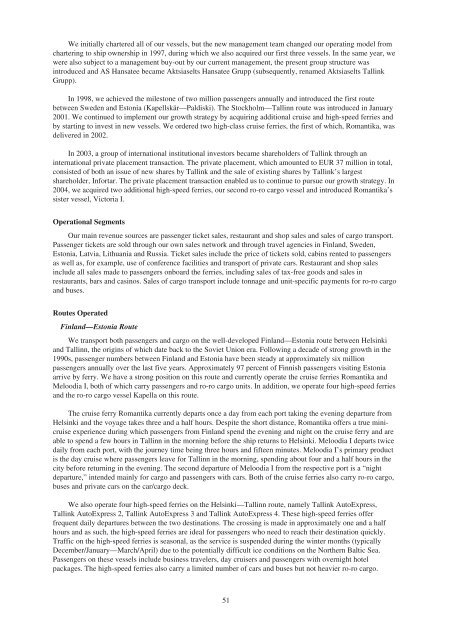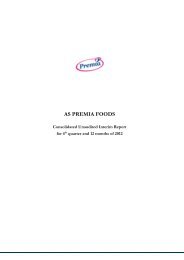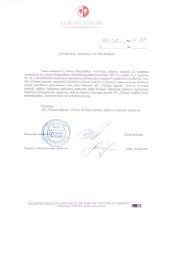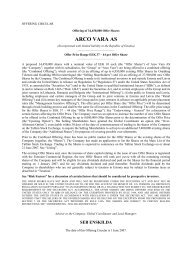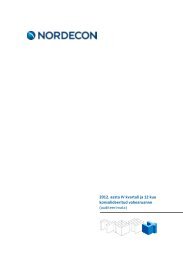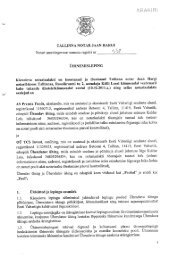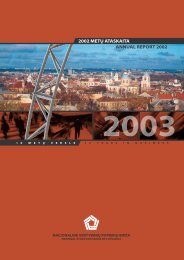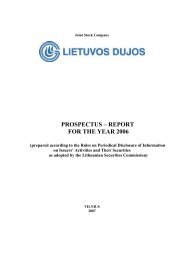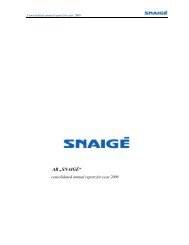Aktsiaselts Tallink Grupp - NASDAQ OMX Baltic
Aktsiaselts Tallink Grupp - NASDAQ OMX Baltic
Aktsiaselts Tallink Grupp - NASDAQ OMX Baltic
Create successful ePaper yourself
Turn your PDF publications into a flip-book with our unique Google optimized e-Paper software.
We initially chartered all of our vessels, but the new management team changed our operating model from<br />
chartering to ship ownership in 1997, during which we also acquired our first three vessels. In the same year, we<br />
were also subject to a management buy-out by our current management, the present group structure was<br />
introduced and AS Hansatee became <strong>Aktsiaselts</strong> Hansatee <strong>Grupp</strong> (subsequently, renamed <strong>Aktsiaselts</strong> <strong>Tallink</strong><br />
<strong>Grupp</strong>).<br />
In 1998, we achieved the milestone of two million passengers annually and introduced the first route<br />
between Sweden and Estonia (Kapellskär—Paldiski). The Stockholm—Tallinn route was introduced in January<br />
2001. We continued to implement our growth strategy by acquiring additional cruise and high-speed ferries and<br />
by starting to invest in new vessels. We ordered two high-class cruise ferries, the first of which, Romantika, was<br />
delivered in 2002.<br />
In 2003, a group of international institutional investors became shareholders of <strong>Tallink</strong> through an<br />
international private placement transaction. The private placement, which amounted to EUR 37 million in total,<br />
consisted of both an issue of new shares by <strong>Tallink</strong> and the sale of existing shares by <strong>Tallink</strong>’s largest<br />
shareholder, Infortar. The private placement transaction enabled us to continue to pursue our growth strategy. In<br />
2004, we acquired two additional high-speed ferries, our second ro-ro cargo vessel and introduced Romantika’s<br />
sister vessel, Victoria I.<br />
Operational Segments<br />
Our main revenue sources are passenger ticket sales, restaurant and shop sales and sales of cargo transport.<br />
Passenger tickets are sold through our own sales network and through travel agencies in Finland, Sweden,<br />
Estonia, Latvia, Lithuania and Russia. Ticket sales include the price of tickets sold, cabins rented to passengers<br />
as well as, for example, use of conference facilities and transport of private cars. Restaurant and shop sales<br />
include all sales made to passengers onboard the ferries, including sales of tax-free goods and sales in<br />
restaurants, bars and casinos. Sales of cargo transport include tonnage and unit-specific payments for ro-ro cargo<br />
and buses.<br />
Routes Operated<br />
Finland—Estonia Route<br />
We transport both passengers and cargo on the well-developed Finland—Estonia route between Helsinki<br />
and Tallinn, the origins of which date back to the Soviet Union era. Following a decade of strong growth in the<br />
1990s, passenger numbers between Finland and Estonia have been steady at approximately six million<br />
passengers annually over the last five years. Approximately 97 percent of Finnish passengers visiting Estonia<br />
arrive by ferry. We have a strong position on this route and currently operate the cruise ferries Romantika and<br />
Meloodia I, both of which carry passengers and ro-ro cargo units. In addition, we operate four high-speed ferries<br />
and the ro-ro cargo vessel Kapella on this route.<br />
The cruise ferry Romantika currently departs once a day from each port taking the evening departure from<br />
Helsinki and the voyage takes three and a half hours. Despite the short distance, Romantika offers a true minicruise<br />
experience during which passengers from Finland spend the evening and night on the cruise ferry and are<br />
able to spend a few hours in Tallinn in the morning before the ship returns to Helsinki. Meloodia I departs twice<br />
daily from each port, with the journey time being three hours and fifteen minutes. Meloodia I’s primary product<br />
is the day cruise where passengers leave for Tallinn in the morning, spending about four and a half hours in the<br />
city before returning in the evening. The second departure of Meloodia I from the respective port is a “night<br />
departure,” intended mainly for cargo and passengers with cars. Both of the cruise ferries also carry ro-ro cargo,<br />
buses and private cars on the car/cargo deck.<br />
We also operate four high-speed ferries on the Helsinki—Tallinn route, namely <strong>Tallink</strong> AutoExpress,<br />
<strong>Tallink</strong> AutoExpress 2, <strong>Tallink</strong> AutoExpress 3 and <strong>Tallink</strong> AutoExpress 4. These high-speed ferries offer<br />
frequent daily departures between the two destinations. The crossing is made in approximately one and a half<br />
hours and as such, the high-speed ferries are ideal for passengers who need to reach their destination quickly.<br />
Traffic on the high-speed ferries is seasonal, as the service is suspended during the winter months (typically<br />
December/January—March/April) due to the potentially difficult ice conditions on the Northern <strong>Baltic</strong> Sea.<br />
Passengers on these vessels include business travelers, day cruisers and passengers with overnight hotel<br />
packages. The high-speed ferries also carry a limited number of cars and buses but not heavier ro-ro cargo.<br />
51


